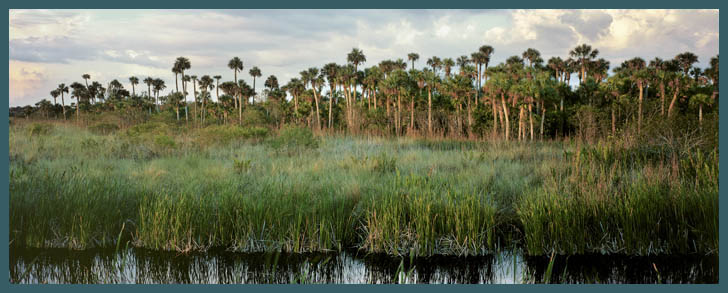|
Florida Everglades
Herons in Florida
Southwest Florida is home to many varieties of herons that include the Great
Blue Heron, Louisiana Heron, Little Blue Heron, Great White Heron, Little Green
Heron, Wurdemann's Heron, and the Night Herons. These beautiful waterbirds are
truly delightful to observe and each have their own distinctive characteristics and
habits. Let's break them down so you can identify which one is which...
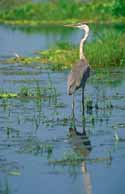 The Great Blue Heron, Ardea herodias, is a large wading bird commonly found
along the shores and in wetland areas of North and Central America. The Great Blue
Heron is the largest of the North American herons, averaging anywhere from 36-55
inches in height. With its body of grey feathers, the neck is brown and its thighs are a
reddish brown, but its cheeks, crown and throat are all white. The bill is a dull yellow
and its long legs are a pale brown, and its wing-span can measure up to six feet. While
its primary food is small fish, it will also feed on other aquatic fare such as crabs,
insects and shrimp, as well as other smaller mammals, reptiles and amphibians –
swallowing it whole. It spears its food with its long sharp bill.
The Great Blue Heron, Ardea herodias, is a large wading bird commonly found
along the shores and in wetland areas of North and Central America. The Great Blue
Heron is the largest of the North American herons, averaging anywhere from 36-55
inches in height. With its body of grey feathers, the neck is brown and its thighs are a
reddish brown, but its cheeks, crown and throat are all white. The bill is a dull yellow
and its long legs are a pale brown, and its wing-span can measure up to six feet. While
its primary food is small fish, it will also feed on other aquatic fare such as crabs,
insects and shrimp, as well as other smaller mammals, reptiles and amphibians –
swallowing it whole. It spears its food with its long sharp bill.
In a bulky stick nest, oftentimes located in a rookery filled with other wading
birds, the Great Blue Heron females will lay anywhere from three to six pale blue eggs
- called a clutch - and only one brood is raised each year. Both male and female will
feed the young by regurgitating their food. The eggs are incubated for around 28 days,
with the chicks hatching asynchronously (not at the same time) over a period of
several days.
Wurdemann's Heron, Ardea wurdemanni, was named after a former
Smithsonian Institute collector of the 1850s, Gustavus Wurdemann. The American
Ornithologists Union (AOU) - the final judge of bird classification in scientific circles
has determined that the Wurdemann's Heron is to be considered another color form of
the Great Blue Heron; much to the chagrin of bird watchers. It can only be found in
very limited numbers in the Florida Keys, catching his fish and often begging from
local fishermen. This heron has a pure white head situated on its grey-blue body.
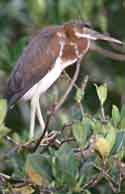 The Louisiana Heron, Egretta tricolor, a tri-colored bird, has been called “Lady
of the Waters” by Audubon because of its beauty and grace. Its name is indeed
misleading, although it does reside in Louisiana, but it can also be found in other
coastal states including North Carolina and Texas as well as Florida. A common bird,
it is much smaller, at approximately 22 inches in height, and more delicate than the
Great Blue Heron that it closely resembles; and its white belly clearly distinguishes it
from all other herons. The Louisiana Heron does not swim, but does wade into deeper
waters and it fishes by striding briskly through the water, oftentimes actually running
after the fish which are caught with a quick thrust of the beak into the water.
The Louisiana Heron, Egretta tricolor, a tri-colored bird, has been called “Lady
of the Waters” by Audubon because of its beauty and grace. Its name is indeed
misleading, although it does reside in Louisiana, but it can also be found in other
coastal states including North Carolina and Texas as well as Florida. A common bird,
it is much smaller, at approximately 22 inches in height, and more delicate than the
Great Blue Heron that it closely resembles; and its white belly clearly distinguishes it
from all other herons. The Louisiana Heron does not swim, but does wade into deeper
waters and it fishes by striding briskly through the water, oftentimes actually running
after the fish which are caught with a quick thrust of the beak into the water.
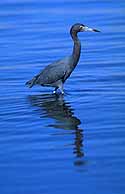 Beginning life as a completely white bird before turning a mottled brown, the
Little Blue Heron, Egretta caerulea, is a small heron, approximately 24 inches in
height, whose feathers finally turn an intense blue that will last for the remainder of
its life. Two major distinguishing features on the Little Blue Heron are its bluish-beak
with a black tip.
Beginning life as a completely white bird before turning a mottled brown, the
Little Blue Heron, Egretta caerulea, is a small heron, approximately 24 inches in
height, whose feathers finally turn an intense blue that will last for the remainder of
its life. Two major distinguishing features on the Little Blue Heron are its bluish-beak
with a black tip.
The statuesque beauty, the Great White Heron, Ardea occidentalis, is indeed a
sight to behold, with its pure white plumage. It can be seen in the Florida Keys as
well as in the Everglades National Park in a town known as Flamingo. Their limited
ranges means small numbers and their populations have been dangerously decimated
by major hurricanes over the years. The Great White Heron National Refuge, located
in the Florida Keys in 1938, was created for their protection.
 The Little Green Heron, Butorides virescens, is known to be a shy bird, keeping
out of human sight whenever possible, who favors both grassy edges of lakes as well as
the swampy areas. This heron measures only 17-inches and adult females tend to be
even smaller than males. The key to its fishing technique is his incredible patience
before the deadly strike. Did you know the Little Green Heron has been dubbed a
“comfort movement” by animal behavioral scientists because of its extraordinary
ability to contract its neck into almost unbelievable lengths? This stretching motion
most likely is useful to the heron when digesting his food. It has been described as the
bird equivalent of taking Rolaids.
The Little Green Heron, Butorides virescens, is known to be a shy bird, keeping
out of human sight whenever possible, who favors both grassy edges of lakes as well as
the swampy areas. This heron measures only 17-inches and adult females tend to be
even smaller than males. The key to its fishing technique is his incredible patience
before the deadly strike. Did you know the Little Green Heron has been dubbed a
“comfort movement” by animal behavioral scientists because of its extraordinary
ability to contract its neck into almost unbelievable lengths? This stretching motion
most likely is useful to the heron when digesting his food. It has been described as the
bird equivalent of taking Rolaids.
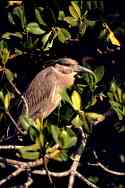 Did you know there were two kinds of Night Herons here in Florida? One is
Yellow-crowned and the other is Black-crowned. The Yellow-crowned Night Heron,
Nyctanassa violacea, can been found feeding in the shallows by those spending time
around the local bays and inland waterways. It is very common here in Florida.
Interestingly though, the Black-crowned Night Heron, Nycticorax nycticorax, is
actually a much larger, roughly 25-inches in height, and stockier bird over the
Yellow-crowned heron, with a spectacular white plume on its head. While common
world-wide, its appearance here in Florida is indeed rare. As their name implies, these
herons “work” at night, fishing in the shallow waters.
Did you know there were two kinds of Night Herons here in Florida? One is
Yellow-crowned and the other is Black-crowned. The Yellow-crowned Night Heron,
Nyctanassa violacea, can been found feeding in the shallows by those spending time
around the local bays and inland waterways. It is very common here in Florida.
Interestingly though, the Black-crowned Night Heron, Nycticorax nycticorax, is
actually a much larger, roughly 25-inches in height, and stockier bird over the
Yellow-crowned heron, with a spectacular white plume on its head. While common
world-wide, its appearance here in Florida is indeed rare. As their name implies, these
herons “work” at night, fishing in the shallow waters.
There are several known locations nearby that are great for observing these
various herons that you might want to check out on your next excursion. In nearby
St. Petersburg, north of the main span of the Sunshine Skyway Bridge you can see
the Great Blue Herons. In our local Corkscrew Swamp Sanctuary, visitors can often
see the Little Blue Herons. On the other coast near the Kennedy Space Center one can
view numerous herons at the Merritt Island National Wildlife Refuge. Heading south
to the Everglades National Park there can often be found large concentrations of
herons and the Florida Keys are known for the beautiful, but vanishing, Great White
Heron as well as possibly the Wurdemann's Heron.
END
The ABCs of the Florida Landscape is written by freelance writer Maureen
Sullivan-Hartung who has resided in Naples now for 30 years and loves learning
about all aspects of the local flora and fauna. Another passion of hers is local history
and she authored a book in November 2010, titled, Hidden History of Everglades City
& Points Nearby, published by The History Press. Check her website for the book's
availability or additional information about the author at >www.maureenwrites.com
msh82011
Be sure to check out these books for additional information on the many types of
herons:
Birds of Florida by Bill Pranty, Kurt Radamaker and Gregory Kennedy, 2006
Birds of Florida Field Guide by Stan Tekiela, 2005
Common Coastal Birds of Florida & the Caribbean by David W. Nellis, 2001
Florida's Birds: A Field Guide and Reference by David S. Maehr, Herbert W. Kale and
Karl Karalus, 2005
Florida's Fabulous Waterbirds by Winston Williams, 1983
Herons (Wetland Animals) by Margaret Hall, children's book 4-8 years, 2006
National Audubon Society Field Guide to Florida by Peter Alden and Rick Cech, 1998
National Geographic Field Guides to Birds: Florida by Mel Baughman, 2005
Seashore & Wading Birds, Patricia E. Pope, 1974
Smithsonian Handbooks: Birds of Florida by Fred J. Alsop, 2002
Photos courtesy of Southwest Florida Water Management
|

